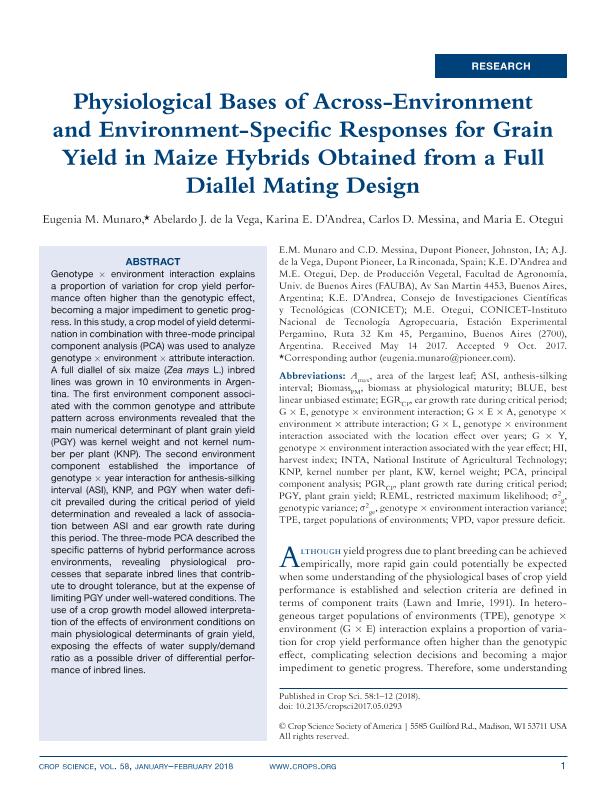Mostrar el registro sencillo del ítem
dc.contributor.author
Munaro, Eugenia

dc.contributor.author
De la Vega, Abelardo J.
dc.contributor.author
D'andrea, Karina Elizabeth

dc.contributor.author
Messina, Carlos D.
dc.contributor.author
Otegui, Maria Elena

dc.date.available
2018-08-16T15:58:16Z
dc.date.issued
2018-01
dc.identifier.citation
Munaro, Eugenia; De la Vega, Abelardo J.; D'andrea, Karina Elizabeth; Messina, Carlos D.; Otegui, Maria Elena; Physiological bases of across-environment and environment-specific responses for grain yield in maize hybrids obtained from a full diallel mating design; Crop Science Society of America; Crop Science; 58; 1; 1-2018; 180-191
dc.identifier.issn
0011-183X
dc.identifier.uri
http://hdl.handle.net/11336/55914
dc.description.abstract
Genotype × environment interaction explains a proportion of variation for crop yield performance often higher than the genotypic effect, becoming a major impediment to genetic progress. In this study, a crop model of yield determination in combination with three-mode principal component analysis (PCA) was used to analyze genotype × environment × attribute interaction. A full diallel of six maize (Zea mays L.) inbred lines was grown in 10 environments in Argentina. The first environment component associated with the common genotype and attribute pattern across environments revealed that the main numerical determinant of plant grain yield (PGY) was kernel weight and not kernel number per plant (KNP). The second environment component established the importance of genotype × year interaction for anthesis-silking interval (ASI), KNP, and PGY when water deficit prevailed during the critical period of yield determination and revealed a lack of association between ASI and ear growth rate during this period. The three-mode PCA described the specific patterns of hybrid performance across environments, revealing physiological processes that separate inbred lines that contribute to drought tolerance, but at the expense of limiting PGY under well-watered conditions. The use of a crop growth model allowed interpretation of the effects of environment conditions on main physiological determinants of grain yield, exposing the effects of water supply/demand ratio as a possible driver of differential performance of inbred lines.
dc.format
application/pdf
dc.language.iso
eng
dc.publisher
Crop Science Society of America

dc.rights
info:eu-repo/semantics/openAccess
dc.rights.uri
https://creativecommons.org/licenses/by-nc-sa/2.5/ar/
dc.subject
Diallel
dc.subject
Genotype X Environment Interaction
dc.subject
Maize
dc.subject
Crop Growth Model
dc.subject.classification
Agricultura

dc.subject.classification
Agricultura, Silvicultura y Pesca

dc.subject.classification
CIENCIAS AGRÍCOLAS

dc.title
Physiological bases of across-environment and environment-specific responses for grain yield in maize hybrids obtained from a full diallel mating design
dc.type
info:eu-repo/semantics/article
dc.type
info:ar-repo/semantics/artículo
dc.type
info:eu-repo/semantics/publishedVersion
dc.date.updated
2018-08-14T18:40:19Z
dc.journal.volume
58
dc.journal.number
1
dc.journal.pagination
180-191
dc.journal.pais
Estados Unidos

dc.journal.ciudad
Baltimore
dc.description.fil
Fil: Munaro, Eugenia. DuPont Pioneer; Estados Unidos
dc.description.fil
Fil: De la Vega, Abelardo J.. DuPont Pioneer; España
dc.description.fil
Fil: D'andrea, Karina Elizabeth. Universidad de Buenos Aires. Facultad de Agronomía. Departamento de Producción Vegetal; Argentina. Consejo Nacional de Investigaciones Científicas y Técnicas; Argentina
dc.description.fil
Fil: Messina, Carlos D.. DuPont Pioneer; Estados Unidos
dc.description.fil
Fil: Otegui, Maria Elena. Universidad de Buenos Aires. Facultad de Agronomía. Departamento de Producción Vegetal; Argentina. Instituto Nacional de Tecnología Agropecuaria. Centro Regional Buenos Aires Norte. Estación Experimental Agropecuaria Pergamino; Argentina. Consejo Nacional de Investigaciones Científicas y Técnicas; Argentina
dc.journal.title
Crop Science

dc.relation.alternativeid
info:eu-repo/semantics/altIdentifier/doi/http://dx.doi.org/10.2135/cropsci2017.05.0293
dc.relation.alternativeid
info:eu-repo/semantics/altIdentifier/url/https://dl.sciencesocieties.org/publications/cs/abstracts/58/1/180
Archivos asociados
